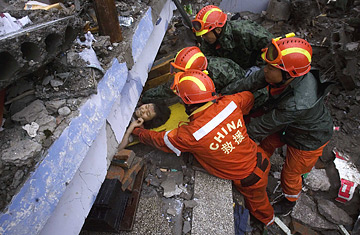
Rescue workers pull out a young girl from under the rubble of a collapsed school in Juyuan.
The official rescue efforts have stopped at the Juyuan Middle School, where at least 600 students were trapped during the violent earthquake in China's Sichuan province, which will leave an estimated 4.8 million people homeless, Chinese authorities said today. But while the workers have left the site of the three-story building in the village of Juyuan, neighbors and parents still gather here to try to comprehend why the children who went off to class Monday disappeared under tons of broken concrete. Some scramble over the debris, searching for any reminders of the dead. Others stand in the muddy, trash-filled lot and discuss the tragedy with a tone that drifts between sadness and rage.
"It was built out of tofu," says Hu Yuefu, 44, of the school building that collapsed in the magnitude 7.9 quake and killed his 15-year-old daughter Huishan. He believes local government officials and the building contractors are responsible. As he speaks, a crowd gathers around to listen and offer their support. "I hope there is an investigation," Hu says. "Otherwise, there are a thousand parents who would beat them to death."
That anger is flowing in communities across the disaster zone. While the overall death toll has passed 21,500 and is expected to climb as high as 50,000, there is special tragedy — and perhaps a whiff of scandal — in the number of young people who died in collapsed schools. Communities like Juyuan have had an entire generation of young people wiped out. In the nearby city of Dujiangyan, more than 300 students were killed when the Xinjian Elementary School collapsed. Sixty miles away in the mountainside town of Hanwang, the scene repeated itself at the Dongqi Middle School, where an estimated 200 students died. Five children were killed when two schools even collapsed in Chongqing, the state-run Xinhua News Service reported. The city is more than 200 miles away from the quake's epicenter.
The devastation is a reminder that for all of its explosive economic growth, parts of China are still painfully poor. While cities like Shanghai boast some of the world's tallest and most advanced buildings, rural areas are often plagued by substandard structures. During the 1990s China updated its building codes to standards that approximate those of the U.S. and Europe, says Greg Wong, a Hong Kong–based structural engineer who has worked in China since 1985. But those standards aren't always met, he says, especially in the countryside. "If they spent more money and build buildings half as good as schools in North America or Hong Kong or even Beijing, I think they would have had a better chance of escaping this disaster," he says.
Part of the problem is money. Until recently local governments were expected to carry up to half of the expenses for local education, says Joseph Cheng, a political science professor at City University of Hong Kong. That created an incentive to skimp. "In the interior provinces, governmental supervision is very lax," he says. Education "is not a priority area. You can cut corners." Even now, provincial economic plans list yearly targets for the reduction of unsafe schools, illustrating the extent to which low school budgets have compromised safety. "It's a widely recognized problem," Cheng says.
Some parents in Sichuan argue that the problem goes beyond shortchanging schools. They allege that local officials are responsible for allowing unsafe buildings to go ahead. "The government and the construction companies collude with each other," says Hu, whose daughter's corpse was pulled out from the Juyuan Middle School two hours after it collapsed on Monday. "It's in their interest to build them poorly."
In China it is often at the local level, where officials have the most direct impact on citizen's lives, that corruption is most common and bears the most painful consequences. While that problem is widely recognized, the collapse of schools after the Sichuan quake has turned it into a major public issue. During a State Council press conference this week, a journalist from the state-run China Daily asked why so many schools were destroyed by the tremor, while government buildings seemed comparatively intact. "It was not just schools that collapsed, but because children were buried we pay close attention to that," replied Wang Zhenyao, disaster relief director for the Ministry of Civil Affairs. "But in Beichuan county the civil administration building collapsed, and there were possibly casualties. The government buildings aren't all that firm." Still, online message boards teemed with demands for answers as to why so many schools were destroyed. "After the disaster is over, there should be an investigation of who built the schools, the material problems and whether there was a problem of corruption. I think there definitely was," wrote one person on a Tianya web forum.
Not everyone in the disaster zone is ready to accuse the local officials of
corruption, but they are still demanding answers. "It's a question we are
asking," says Feng Jianyun, 34, who was sitting outside the Jiuzhou Sports
Center in Mianyang, which has been turned into a center for thousands of
people left homeless by the quake. "How could a place with so many people
inside not be built better? That's what I want to know. We should not forget
a lesson that has been learned in blood."
with reporting by Lin
Yang/Dujiangyan
